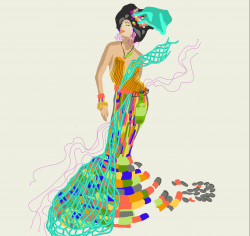If you were built to be nothing more than a political toy, what would you do in the face of a life-threatening revolution outside your palace gates? The Woolly Mammoth Theatre Company’s rendition of David Adjmi’s Marie Antoinette directly confronts this question, presenting a modern interpretation that challenges viewers to reimagine history’s “famous-for-being-famous” queen. Director Yury Urnov turns the classic on its head, bringing a contemporary bang to the scandals, decadence, and protests. Antoinette, played by Kimberly Gilbert, wades around her Jacuzzi in striped bikinis, engages in steamy love affairs, and poses for the paparazzi in her world at Versailles.
The first half of the play follows Antoinette’s life at court, carried out in provocative wisps of conversations and encounters. Draped in pink silk and embellished in glass, the stage becomes a modern Versailles—built more for the likes of the Kardashians than the 18th century French elite. Flashing lights and bass-heavy music turn Antoinette’s life into an endless, wig-strutting catwalk, with all of Europe as her audience. But between the hypnotic beats and ceaseless attention, glamour, and glitter, Urnov reveals a terrified teenage girl given neither enough time to grow up nor an option to refuse what life—or higher powers—had in store for her.
Gilbert handles these complex layers of Antoinette’s character with a well-orchestrated delicacy. Bursts of emotional arguments with Louis XVI, played by Joe Isenberg, demonstrate a painful marriage that Antoinette ascribes to being arranged for the sake of political alliance. Bitter tirades from her mother, the powerful Maria Theresa of Austria, and her older brother, Joseph II, chastising Antoinette’s “heterodox behavior” show complex family relations and high expectations. And of course, the citizens of France have chosen Antoinette, the unwelcomed foreigner, as an icon of everything wrong with the country. Antoinette was by no means completely innocent and the production doesn’t hide her fervent gambling and even more fervent spending habits, but the young queen was merely doing what she was consigned to do.
As a company that has accrued a reputation for its artistic audacity and defiance of traditional norms, Marie Antoinette proves to be an appropriate opening for the 35th season for Woolly Mammoth. Urnov’s production truly adds the troupe’s provocative flavor through the deliberate and extreme modernization of an otherwise traditional story. The grandeur of Versailles is transformed into a wasteland of trashy extravagance, an aesthetically important touch that makes the character’s lives only more frustrating for modern audiences. While life at the Chateau dominates the first half, the second focuses on Antoinette’s imprisonment in the Palace of the Tuileries, then the Conciergerie Prison. Despite the change in location, the same concrete backdrop stained with graffiti spelling out modern slurs like “la garce d’Austriche” (“the bitch from Austria”) remain, representing the overwhelming torment Antoinette experiences.
The extent to which Marie Antoinette’s world mirrors our own is no coincidence. From the colloquial language to Marie’s paparazzi poses, Adjmi works to draw a clear parallel. The play demands reflection on how our supposedly advanced society still reflects the socioeconomic crookedness of late 18th century France. It serves as an intense wake-up call to a culture obsessed with moulding celebrities into idols, only to slam and abandon them once fans find a new phenomenon to worship. As Antoinette spends her last days in prison, heart-stricken with the hues of the Tricolour symbolically dripping down her pale face, viewers see no arrogant queen. Rather, they see a child flung away from home and drowning in a role that she never had the desire to be.





